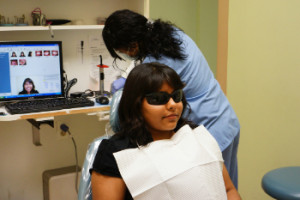This week on our Facebook page, we asked you when Nitrous Oxide, also known as “Laughing Gas” was first introduced into dental procedures. Keep reading to learn all about N2O!
What is Nitrous Oxide
What is Nitrous Oxide? The chemical’s official name is Dinitrogen monoxide and it is written chemically as N2O (see our Dental Funnies album for a light-hearted chemistry lesson from Grumpy Cat).
Nitrous Oxide is also known as “laughing gas” and was first discovered in 1772 by Joseph Priestly, but also occurs naturally through bacteria in the soil and oceans. At first Nitrous Oxide was used by the wealthy as an, *ahem,* “recreational” substance as inhaling Nitrous Oxide is known to produce effects such as euphoria and disassociation. Laughing gas is also used to boost the power output of cars and other vehicles. “Nitrous” (the most common brand is NOS), appears in many movies involving modified street racing cars.
Nitrous Oxide was first introduced into dentistry in 1846 by Horace Wells. Dr. Wells was a dentist in Boston, MA and began demonstrating the use of Nitrous Oxide during dental procedures to relieve some of the pain and anxiety that have been associated with dental issues since, well, since a long time ago. Unfortunately things didn’t go so well for Dr. Wells. During a demonstration in front of a group of other doctors, the Nitrous Oxide was not administered properly and the patient cried out in pain. Needless to say, Dr. Wells was laughed out of the operatory (pun unfortunately intended). However, Nitrous Oxide use was further developed and refined and is now a very popular and common treatment option in dentistry.
Today, Nitrous Oxide is available in many dental clinics, including 1st Family Dental offices.
The American Dental Association and other dentistry journals have conducted research and studies, and have found Nitrous Oxide to be safe to use on both children and adults. Nitrous Oxide is administered in combination with Oxygen (02), via a small mask that fits over the nose. The effects of Nitrous Oxide wear off very quickly, typically within minutes after the flow of gas has stopped.
Patients most commonly report feelings of disassociation (not caring), some giddiness, and general relaxation when experiencing Nitrous Oxide. Side effects of Nitrous Oxide are generally very mild, and may patients do not experience side effects at all. Most dentists recommend not eating for 2 hours prior to the procedure.
Laughing Gas is not IV Sedation: Nitrous Oxide is sometimes confused with IV sedation. IV sedation is administered through the blood stream, and requires special licensing and monitoring for use in dentistry. Remember that video that went viral – David After the Dentist – little David is in the car acting a bit loopy after his dental appointment. Nitrous Oxide got a bit of a bad rap from this video because some folks thought the sedation method was N2O. Doctors and dentists who have viewed this video have agreed that David had undergone IV sedation for his procedure. The effects of laughing gas wear off within minutes, which makes N2O a great sedation method for busy patients and families who need to get right back to their days!
Would you like to learn more about Nitrous Oxide as a possible option for you or a loved one? Feel free to speak to any 1st Family Dental doctor at your next visit, or call any of our offices anytime for more information.




2 Comments
Leave your reply.